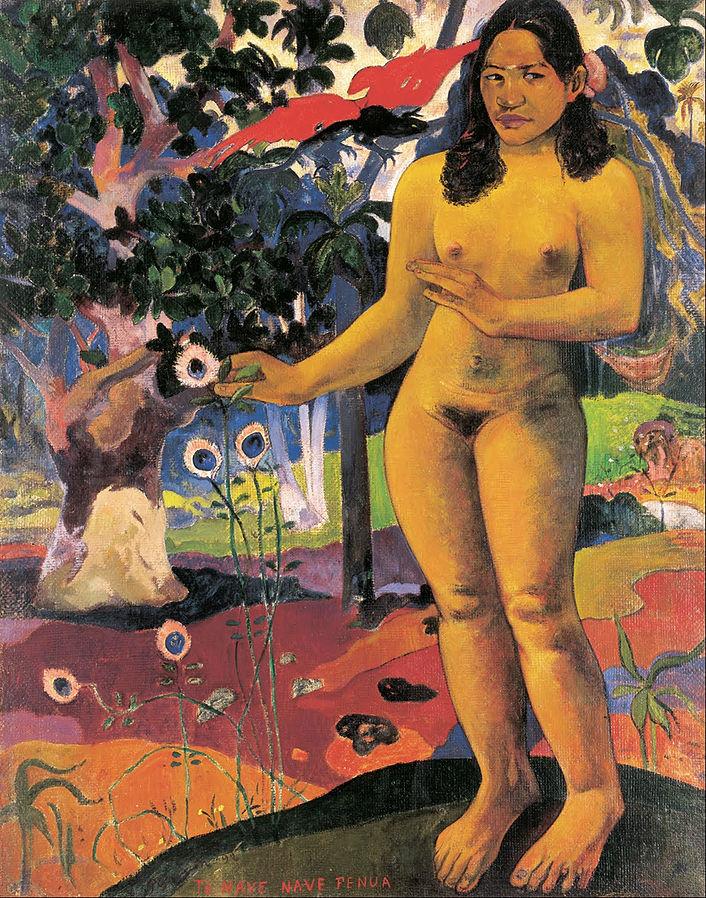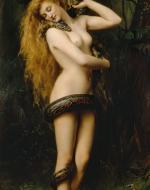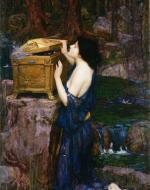Created by Allison Schroeder on Fri, 02/17/2023 - 09:31
Description:
Display Explanation-
My paintings will be displayed in a dark room, with walls painted matte black and a bright spotlight on each painting. I want it to be bright enough to illuminate just the painting and not wash out the features of eac woman depicted. I think this will really highlight the paintings themselves. The light and dark also contrasts the meaning of the paintings: that the first woman is responsible for all evil in the world. Darkness is known to represent evil, so, having darkness behind the paintings and light directly on them serves as contrast for the meaning behind it. This sort of juxtaposition serves as a way to divert blame away from these women. It was not really their fault that they created evil. It was created by a male figure they interacted with, they were just forced to take the blame for it.
I want the room to be spacious so each painting has room to itself. All of the paintings range in size. I would put John Williams Waterhouse's 1896 Pandora first, then Paul Gauguin's 1894 Delightful Land (Te Nave Nave Fenua), then John Collier's 1889 Lilith. I think this makes the most interesting ordering as Delightful Land (Te Nave Nave Fenua), is the smallest painting at 35.9 by 28.3 inches. Pandora and Lilith are larger at 59.8 by 35.8 inches and 76 by 41 inches, respectively. This juxtaposes each painting in a way that is less flowy and more abrupt, so it doesn't feel as if there is any successive way one should look at the paintings. I don’t want to draw attention to any one painting over the others. They all have the same meaning: that the first woman is responsible for evil. So, no one painting should have more focus than the other.
I want the installation to be more simple to place emphasis on the art itself, but I would like to have a sort of red sheen on the walls behind the paintings, splattered at random and perhaps in some hand prints, to emphasize the idea that the first woman is responsible for evil. The spotlight will have enough room that you can see the red, without the red being the focal point of the installation. I think this can be done in a way that suggests that these women “have blood on their hands,” which is a way of saying they are guilty. I want this aspect of the installation to be subtle. I think it would be hard to see the dark red on black walls, but it will contrast the dull matte of the walls. Although it will be subtle, so hard to notice at first, I feel like once it is noticed it will be hard to ignore. I’d like to do this to mirror the subtlety of each painting's suggestion that women are responsible for all evil. It is not apparent at first that these women are the subject of guilt, but further investigation shows that they are the first women in their cultures who must take the blame for the birth of evil.
Installation Note-
Each woman depicted is the “first woman” in different religions. Pandora was the first woman in Greek mythology, who opened a box given to her husband by Zeus that released many evils into the world. She shut the box before releasing hope. Eve was the first woman in Abrahamic religions. She ate the fruit in the Garden of Eden that was forbidden by God, and convinced her husband Adam to do so as well. When she did this it created sin, and therefore created all evil. Lilith is the first woman in Judaic mythology, who was Adam’s husband before Eve. Lilith was created out of the same clay that Adam was created out of. They were equals so she refused to be submissive to Adam. She flees the Garden of Eden and becomes the mother of demons. She literally gives birth to evil.
Paul Gauguin's 1894 Delightful Land (Te Nave Nave Fenua) depicts Eve in the Garden of Eden. A creature lurks above her. This creature is the devil disguised as a Chimera convincing Eve to pluck the evil flower, thus creating all evil. Eve’s eyes are to the side of her face, suggesting that she is looking around her to see if she should, in fact, pick the evil flower. She knows it's wrong. God told her not to, but still she picks the flower. Her facial expression suggests that she does this on purpose, like she wants to create all evil. Really, she is motivated by the Chimera
John Williams Waterhouse's 1896 Pandora depicts Pandora opening the box given to her by Zeus. Her face suggests something of curiosity for what is in the box. The wisps escaping from the box are the evils, namely sickness and death. Her curiosity, her temptation, led to the release of evil. It wasn’t her intention. Zeus put the box in her possession, but she is blamed for it. She is also in nature and secluded from others in a way, suggesting that she is doing this in secret it is her intention to release evil into the world.
John Collier's 1889 Lilith depicts Lilith with a snake, wrapped around her. This serpent is the devil in disguise again. Her posture suggests something inviting, like she is enjoying the presence of the snake. She has long red hair, which is suggestive of something immoral. The snake is actually tangled in her hair, which shows that they are one in the same. She invites temptation and decides to go with the devil. This painting more or less merges the story of Eve with the story of Lilith. Lilith didn’t really collude with the devil. Instead she refused to be subservient to Adam, she saw herself as equal. Her banishment from the Garden of Eden cements her as the mother of demons. She literally gives birth to evil. This painting suggests that she was colluding with the devil the whole time, which is why she refused Adam.
All three paintings are suggestive of female sexuality and temptation. Every woman feeds into her temptation which leads to the creation of evil in each respective culture. The suggestion is that female sexuality is so wrong, that it is inherently the cause for all evil. In each painting, the woman is depicted in a sexually suggestive way. Eve and Lilith are blatantly naked. Pandora is depicted in a way that would be explicit for the time period. Her shoulders are showing and her dress scoops close to exposing her breasts. Each of these women are expressing their truest form and are shamed for it. They are in some way tempted or convinced by a male figure to do this. Really, they themselves did not create evil, the male figures did, but they must take the blame as the catalyst for it.
Collier, John. Lilith. 1887. https://commons.wikimedia.org/wiki/File:Lilith_(John_Collier_painting).jpg. Accessed 16 February 2023.
Gaugin, Paul. Delightful Land (Te Nave Nave Fenua). 1892. https://commons.wikimedia.org/wiki/File:Paul_Gauguin_-_Delightful_Land_(Te_Nave_Nave_Fenua)_-_Google_Art_Project.jpg. Accessed 16 February 2023.
Waterhouse, John Williams.Pandora. 1896. https://commons.wikimedia.org/wiki/File:John_William_Waterhouse_-_Pandor.... Accessed 16 February 2023.
Copyright:
Associated Place(s)
Artist:
- Multiple Artists




